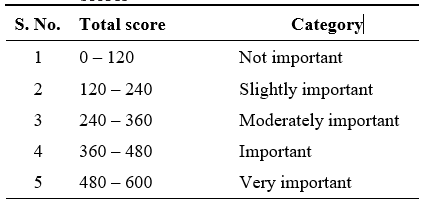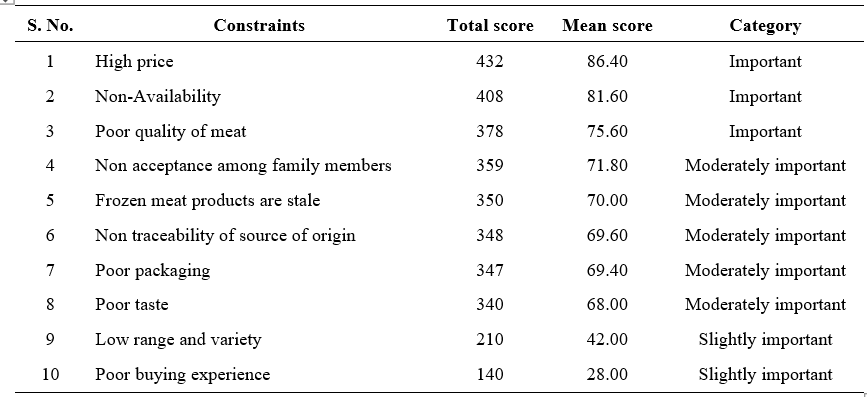Constraints in Purchasing of Frozen Meat and Meat Products in Andhra Pradesh
0 Views
M. MOHITH SAI*, N.T. KRISHNA KISHORE, P. BALA HUSSAIN REDDY AND B. RAMANA MURTHY
Institute of Agribusiness Management, S.V. Agricultural College, ANGRAU, Tirupati-517502.
ABSTRACT
The present study was done to identify the constraints in purchasing of frozen meat and meat products in Andhra Pradesh.
A representative sample of 120 meat consumers in three cities of Andhra Pradesh i.e., Vishakhapatnam, Vijayawada, and Tirupati were taken for the study. A consumer purchasing behaviour model was developed from the results of study for purchasing of the fresh meat and frozen meat. The major market stimuli for buying of meat was driven from consumer stimuli and consumer motives towards meat. The major consumer constraints in purchasing frozen meat and meat products reveals that high price and non-availability are important constraints. The moderately important constraints were non acceptance among family members, Frozen meat products are stale, Non traceability of source of origin, Poor packaging’ and Poor taste, respectively.
KEYWORDS: Consumer constraints, frozen meat, meat products, consumer behaviour model.
INTRODUCTION
Consumption of meat played a crucial role in human evolution and is an important component of a healthy and well-balanced diet due to its nutritional richness. A healthy balanced diet can include protein, meat being one of the important and affordable sources of protein. Meat is mostly made up of beneficial proteins, lipids, vitamins, minerals, omega 3 fatty acids, and conjugated linoleic acid that provide a variety of nutrients for human health.
According to the 2021 report by the market research company, IMARC, the frozen food, industry in India is spreading its wings and is expected to expand at a Compound Annual Growth Rate (CAGR) of 17 per cent between 2019-2024. The market for frozen foods comprises of “frozen meat products,” “frozen greens,” “frozen fruits,” and “frozen vegetables.” Since frozen foods don’t require any of the additional preparation or culinary skill, they are becoming more and more popular in India. Moreover, frozen food products, especially the frozen meat products offer enhanced palatability when compared to their home-cooked counterparts, these products are available all-year-round regardless of the season. Furthermore, the end-users can buy those products through different distribution channels such as supermarkets and hypermarkets, convenience stores, departmental stores, etc.
The study helps to understand the constraints in purchasing of frozen meat and meat products in Andhra Pradesh.
MATERIALS AND METHODS
The survey was done in the Andhra Pradesh state, which ranked third in meat production. This study was conducted purposively in Vishakhapatnam, Vijayawada, and Tirupati. These cities consist of wide variety people with different religions, castes, occupations, culture, languages and food habits. These cities act as an educational hub for whole state and also rapidly incorporating the urban culture. The study’s necessary information will be gathered from corresponding references and the meat consuming respondents using a pre-tested timetable and numerous in-person visits.
STUDIES ON CONSTRAINTS FACED BY CONSUMERS WHILE BUYING FROZEN MEAT AND MEAT PRODUCTS.
Information regarding constraints in purchasing of frozen meat and meat products were analyzed. In
Table 1. Categorizing the constraints based on total scores

Table 2. Constraints in purchasing of frozen meat and meat products

order to measure constraints in purchasing of the frozen meat and meat products., the opinion of the sampled consumers was analyzed using a five-point rating scale, with the least considered statement rated as one (1) and the most considered statement rated as five (5). The scores obtained for each identified parameter were summated, and the respective means were estimated and are arranged in ascending order as per the mean values obtained. The identified parameters were categorized into very important, important, moderately important, slightly important and not important according to their mean values, as shown in the Table 2.
The constraints are categorized in to five categories based on the total score given below.
The constraints obtaining the total score 0-120 falls under ‘not important’ category, the constraints obtaining the total scores of ranges 120-140, 240-360, 360-480 and 480-600 falls under categories slightly important, moderately important, important and very important, respectively.
The results of Table 2 indicates the constraints in purchasing of frozen meat and meat products. The constraints like “High price”, “non-availability” and “Poor quality of meat” are categorised as important constraints with mean scores of 86.40, 81.60 and 75.60 respectively as frozen meat is not available as widely as fresh meat in the sample area. The constraints like non- acceptance among family members frozen meat products are stale, non-traceability of source of origin, poor packaging and poor taste falls under moderately important constraints with their mean score of 71.80, 70.00, 69.60, 69.40, and 68.00, respectively. Whereas the constraints like low range and variety and Poor buying experience lies in the category of slightly important constraints with mean score of 42.00 and 28.00, respectively. Hence, the most important constraints in purchasing of the frozen meat and meat products were high price, non-availability and poor quality of meat.
Consumer purchasing behaviour model for frozen meat and meat products
Figure 1 shows, the consumer purchasing behaviour model was developed from the results of study. The major market stimuli for buying of meat was driven from consumer stimuli and consumer motives towards meat. The critical consumer stimuli for meat purchasing decision making were meat being considered as rich source of protein and tasty. The consumer motives were influenced from beliefs like “meat is good for healthy lifestyle”, “consumption of meat is in family/religion culture” and “consumption of meat gives social esteem (social status)”. The consumer psychology towards preferring of fresh meat over frozen meat was considering frozen meat products as stale, harmful for health and poor in taste. While perception of consumers favouring towards frozen products were frozen meat suitability for preserving long time when compared to fresh meat, Various meats available in off season in frozen form with wide range of products.

The buying decisions towards fresh meat was due to the influencing factors like quality and taste. the major factors influencing the buying decisions of frozen meat products were mostly augmentation factors like off season availability, easy to cook and pre-preparedness of products followed by convenience factors like Convenience of storing and using as per requirement, Time saving, affordability and certificated Halal cutting/ FSSAI and the flexibility factors also influences the buying decisions which includes wide range/ variety and flexibility of any time meal preparation. Based on the market stimuli, consumer psychology and buying decisions the purchasing decision are taken by consumers whether to buy fresh meat or frozen products. Further across the consumers willing to buy frozen meat take purchase decisions for frozen ready to fry, frozen heat and eat products, frozen ready to cook and frozen meat as per their buying decision previously made. The consumers after deciding to purchase they decide the place of purchasing, for fresh meat places preferred by consumers are butcher shop and specialized meat mart, where as for frozen products they choose super markets and online shopping. While final decisions depend on products, they are willing to purchase based on earlier market stimuli they receive. Consumers were mostly preferring products like fish, sea food and poultry meat in frozen form where as eggs and poultry meat were mostly consumed in fresh form.
The constraints like “high price”, “non-Availability” and “Poor quality of meat” are categorised as important constraints respectively as frozen meat is not available as widely as fresh meat in the sample area. The constraints like Non acceptance among family members ‘Frozen meat products are stale’, ‘Non traceability of source of origin’, ‘Poor packaging’ and ‘Poor taste’ falls under moderately important constraints. Whereas the constraints like ‘Low range and variety’ and ‘Poor buying experience’ lies in the category of slightly important constraints.
LITERATURE CITED
Felderhoff, C., Lyford, C., Malaga, J., Polkinghorne, R., Brooks, C., Garmyn, A and Miller, M. 2020. Beef quality preferences: Factors driving consumer satisfaction. Foods. 9(3): 289.
Font-i-Furnols, M and Guerrero, L. 2014. Consumer preference, behavior and perception about meat and meat products: An overview. Meat Science. 98(3): 361-371.
Larissa S. Drescher, Janneke de Jonge, Ellen Goddard and Thomas Herzfeld. 2012. Consumers stated trust in the food industry and meat purchase”, Agric Human Values, 29(4): 507-517.
Maeve, H., McCarthy, M., Virginia, C.R and Declan,
- 2014. Meat consumption: trends and quality matters. Meat Science. 98(3): 561- 568.
- Genetic Diversity Analysis of 64 Maize Inbred Lines for Yield Traits Using D2 Statistics and Principal Component Analysis
- Effect of Border Crops on Activity of Predatory Fauna In Blackgram (Vigna Mungo L.)
- Effect of Organic Nutrient Management Practices on Growth and Yield of Foxtail Millet
- Species Diversity of Sugarcane Shootborers in Major Sugarcane Growing Districts of Andhra Pradesh
- Faunistic Studies on Economically Important Lepidopterans in Different Field Crops of Tirupati District
- Production Potential of Sweet Corn as Influenced by Organic Manures and Foliar Nutrition

